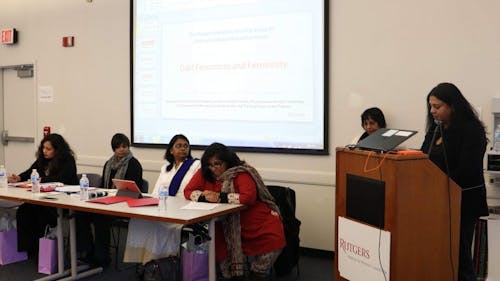Panel on Indian feminism, caste system gives Rutgers new perspectives

The Rutgers University Working Group on Dalit and Adivasi Research presented a panel discussion on Dalit feminism and femininity at the Ruth Dill Johnson Crockett Building.
The event, which occurred last Thursday, featured five panelists and had approximately 25 students and faculty in attendance, was sponsored by the Institute for Research on Women, Rutgers Global, the Institute for Women's Leadership, the Department of Women’s and Gender Studies and the South Asian Studies Program, said Julie Rajan, an assistant professor in the Department of Women’s and Gender Studies.
The panel is the first of a two-panel series that aims to draw attention to the distinct experiences of Dalit and Adivasi communities, Rajan said, as well as their advocacy efforts by highlighting the experiences and research of Dalit and Adivasi women and allies.
Dalits, who used to be known as the “untouchables” of India’s caste system, Rajan said, make up 25 percent of India’s population and the majority of India’s slums.
Making their livelihoods by cleaning human waste from streets and public toilets, Dalits have been physically and socially segregated from Hindus of other castes due to misinterpretations of ancient Hindu texts by heterosexual male Brahmins, or members of the highest Hindu caste, she said.
Adivasis, or tribal people, have different experiences defined by forced eviction and the appropriation of homelands and environmental resources by British colonial government and post-colonial Indian government. Rajan said more than 700 Adivasi tribes living in forests across India make up 10 percent of the Indian population.
In 1991, Rajan said the Indian government combined both the Dalit and Adivasi groups into one broad category of Scheduled Castes, or SC, Scheduled Tribes, or ST and Other Backward Classes, or OBC, in attempt to increase the visibility and agency of both communities.
Since then, India has done little to change the cultural biases that justify the dehumanization of both communities despite global attention brought to the issue in 2010 by the United Nations decision against discrimination based on labor and lineage, Rajan said.
Females of both communities experience a range of violence distinct to both their caste and gendered identities, Rajan said.
“It is a myth to think that we can deal with these issues one by one: Gender equality first and Dalit equality next. We must look at the common site of the female Dalit body as the site at which the struggles of caste, gender, and race are fought,” said Evangeline Anderson-Rajakumar, a body theologian and Dalit womanist scholar.
Anderson-Rajakumar, as a Dalit woman, spoke about her realization that she was a devalued body in society and that her starting point was not zero, but negative.
“You spend your lifetime trying to get from negative to zero, and it takes another lifetime to move forward,” she said.
Caste, Andersen-Rajakumar said, is an imagination of purity and a requisite of the powerful. Members of the upper caste need the female Dalit body in order to define oneself and one’s caste as superior.
This, she said, is what leads to violence and discrimination against Dalit women and what gives Dalit women the potential to advocate for their rights.
“It is right that they think that Dalit and female bodies are dangerous, it is those bodies that have the power to demystify the caste system,” she said.
Manjula Bharathi, a professor at the Tata Institute of Social Sciences in Mumbai, India, agreed with Anderson-Rajakumar and described the common practice of upper-caste members serving tea to Dalits in separate cups.
“The moment you are given a separate cup, break the cup,” she said.
Bharathi, a non-Dalit woman, began a discussion on the value of the experiences of other feminist groups to the plight of Dalit women.
Jebaroja Singh, a visiting assistant professor at St. John Fisher College in Rochester, New York, also spoke about the importance of applying a transnational feminist lens to the Dalit women’s movement.
She also said that activism played a unique role in the Dalit women’s movement.
“Activism is survival, not just a method of expression of feminism for these Dalit women,” Singh said.
Thenmozhi Soundararajan, the executive director of Equality Labs and a member of the Dalit community, echoed this thought and explained her expectations of transnational feminist groups.
“We don’t have the luxury to write papers about this, we have to take to the streets and speak our truth until our people are free. We don’t have time to wait for movements that don’t speak to our issues,” she said.
For Soundararajan, Dalit feminism holds radical potential for both India and the rest of the world. To realize this potential, she said, the international women’s movement should not erase the intersectionality of feminism.
“We don’t see ourselves in isolation,” she said. “We see ourselves in collection with many feminist groups.”



